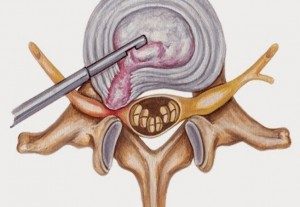Lumbar Endoscopic Discectomy Surgery
For Leg or Lower Back Pain Relief
• Minimally Invasive Herniated Disc Surgery Option
• The patient is Sedated and Awake
A Lumbar Endoscopic Discectomy is a minimally invasive surgical procedure to remove a portion of the disc and decompress nerves in the lumbar spine. The entire procedure is performed through a small tube which is several millimeters in diameter. The entry site of the tube through the skin is toward the side of the back.
This procedure allows the surgeon to gain access to the disc space without having to make a larger incision and pull back and retract on the muscles of the back.
Lumbar endoscopic discectomy may be performed to reduce lower back pain or it may be performed to take the pressure off of a nerve in the lumbar spine to decrease leg pain.
During the Lumbar Endoscopic Discectomy, the patient is brought to the operating room and placed on their abdomen. They are sedated to make the procedure as pleasant as possible, but are kept awake enough to make sure that nerves are not being irritated and the instruments pass into the disc space.
A small puncture site is made on the side of the back in order to pass the endoscope and other instruments into the disc space. Once the instruments are in the disc space, the surgeon begins to remove some of the disc material.
In patients with lower back pain, any offending disc fragment is often seen herniating through a tear in the annulus fibrosis, which is the firm outer band of the disc space that holds the nucleus pulposus in place.
Once the operation is complete, the endoscope is removed and the puncture site is closed. On occasion, puncture sites may be placed on both sides of the back as the endoscope may be used from both sides.
Patients are generally discharged home the day of surgery. Pain in the low back or leg is usually improved although the patient may experience numbness or tingling in the leg. Nerves can take quite a while to heal and the patient may experience some numbness and tingle in the legs. Back pain may be significantly improved.
Patients are advised to avoid bending, lifting, or twisting for several weeks after the surgery to a decreased the likelihood of another disc fragment breaking loose.
Risks of the surgery are generally low. Potential risks include bleeding, infection, nerve injury, spinal fluid leak and recurrence of another disc herniation at the same level.
